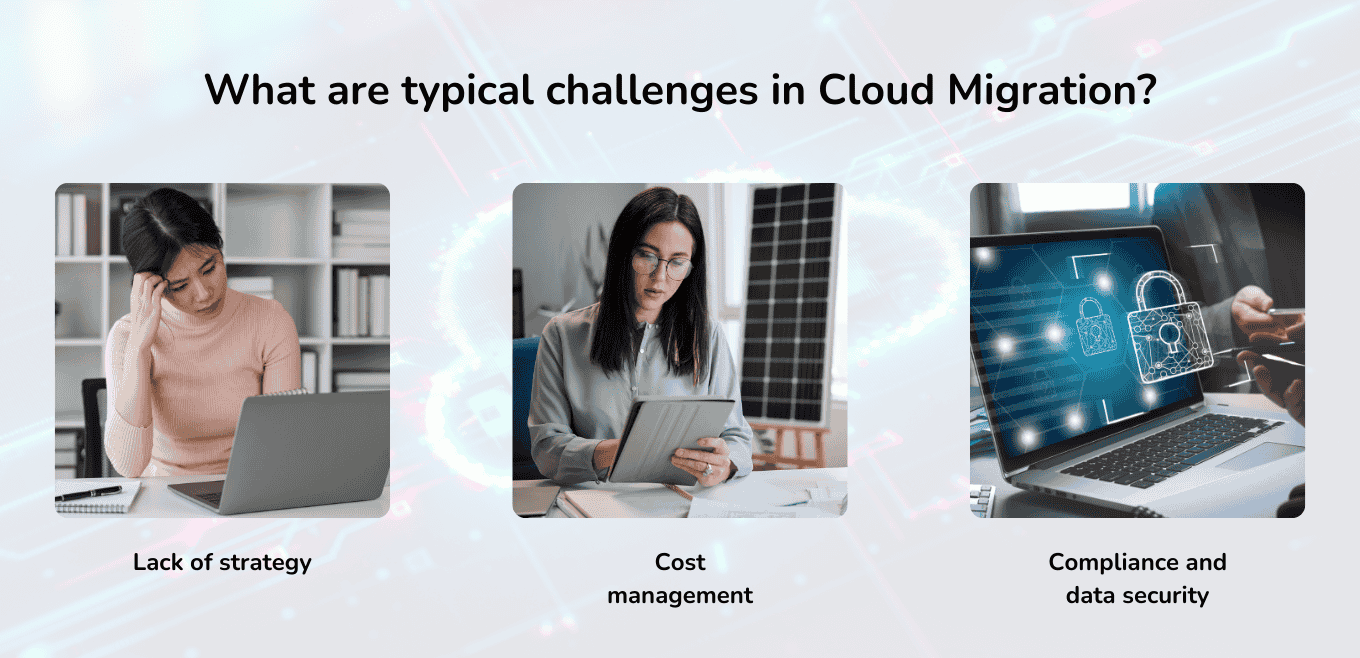Cloud migration has emerged as a crucial step in helping businesses adjust to the changing digital landscape and achieve increased security, scalability, and efficiency. The process of moving data, apps, and on-premises infrastructure to a cloud computing environment is known as cloud migration. This transition entails a fundamental adjustment to the way a business functions.
A well-executed cloud migration strategy can provide several advantages, from improved security and developer experience to higher scalability and cost-effectiveness, regardless of the size of your company. Come along as we examine the best practices for a smooth cloud transfer and delve into the nuances of cloud migration strategy.
How to evaluate the Cloud readiness of your current infrastructure
Evaluating the current infrastructure and apps for cloud readiness is the first step in creating a successful cloud migration plan. This evaluation is essential since it aids in determining possible obstacles, dangers, and possibilities related to the migration process. Organizations can make well-informed decisions and create a thorough plan to guarantee a seamless cloud migration by carefully assessing the current infrastructure and apps.
1. Assessing the existing facilities
It is crucial to assess the current infrastructure to ascertain its compatibility with cloud technologies before starting a cloud migration process. Analyzing the existing networking, storage, hardware, and security systems is part of this evaluation.
Organizations can find any gaps or restrictions that must be fixed before moving to the cloud by knowing the capabilities of the current infrastructure. Determining the possible cost savings and efficiency improvements that can be attained through cloud adoption is another benefit of this evaluation.
2. Evaluating the applicability
Not every application is a good fit for cloud migration. Thus, it is essential to evaluate each application’s suitability before incorporating it into the migration plan. Analyzing elements like data sensitivity, dependencies, resource requirements, and application complexity are all part of this evaluation.
In general, cloud-native architectures, loose coupling, and scalability make applications easy to move. However, for monolithic legacy applications with close dependencies to work, more significant changes or re-architecting may be necessary.
3. Determining the needs for security and compliance
Any cloud migration strategy must take security and compliance very seriously. To guarantee a smooth cloud migration without jeopardizing data integrity or legal commitments, organizations must assess the security protocols and compliance standards in place.
Finding any dangers, weak points, and compliance gaps that require attention is part of this examination. It also entails assessing how well cloud service providers can satisfy the unique security and compliance requirements of the company.
4. Analyzing scalability and performance
Determining if a cloud migration plan is feasible requires evaluating the scalability and performance needs of apps. To determine whether they can be accomplished in a cloud environment, organizations must assess the performance and scalability parameters of their current applications.
Finding resource bottlenecks, patterns of peak demand, and projected increases are all part of this analysis. Organizations can plan for the required infrastructure and configuration changes to guarantee the best possible performance and scalability in the cloud by being aware of these variables.
5. Taking into account integration and data needs
Any organization’s data is a vital resource, and managing it during the transfer process is crucial. Analyzing data storage, backup, and recovery procedures is part of the process of evaluating data and integration requirements. Assessing integration points with other systems, including databases, APIs, and third-party services, is another aspect of it. By being aware of these needs, firms may create a migration plan that guarantees ongoing integration procedures, low downtime, and smooth data transfer.
One of the most important steps is evaluating the present apps and infrastructure for cloud optimization. Organizations can identify possible obstacles and create a well-informed plan for a successful migration by assessing the current infrastructure, application suitability, security, and compliance requirements, performance and scalability demands, and data and integration requirements. Organizations may reduce risks, maximize resource use, and take advantage of cloud technologies’ full potential by using this assessment.
What are typical challenges in Cloud Migration?

Cloud migrations can be dangerous and complicated. These are a few of the main issues that many businesses are having when they move their resources to the cloud.
Lack of strategy
Many businesses begin their cloud migration without giving their plan enough thought or time. Thorough end-to-end cloud migration planning is necessary for successful cloud adoption and deployment. Every application and dataset may have unique needs and factors to take into account, necessitating a separate cloud transfer strategy. Every workload that the company moves to the cloud needs to have a well-defined business justification.
Cost management
Many firms do not have clear KPIs in place when they migrate to the cloud, making it difficult to determine how much they will save or spend after the transfer. This makes comprehension challenging. Because of this, it is challenging to determine whether migration was beneficial from an economic perspective. Furthermore, because cloud environments are dynamic, prices may fluctuate quickly as new services are added and application demand increases.
Compliance and data security
A significant barrier to cloud migration is compliance and data protection. Cloud services operate on a shared responsibility model, meaning that the customer is in charge of protecting data and workloads while the cloud provider handles infrastructure security. Therefore, even though the cloud provider might offer strong security measures, your company must set them up properly and make sure that all services and apps have the right security controls.
There are security hazards associated with the migration process itself. Significant exposure results from transferring huge amounts of potentially sensitive data and setting up access rules for apps in various locations.
Empowering Engineering Teams with People10's CI/CD Deployment Platform
Through our CI/CD deployment platform, People10 helps your engineering team become great individual contributors and maximizes your investments in Kubernetes and the cloud.
How to successfully execute a successful Cloud Migration strategy
A cloud migration strategy is an essential step for businesses looking to make use of cloud computing. It entails moving infrastructure, data, and apps from legacy or on-premises systems to the cloud. A successful cloud migration needs meticulous preparation and implementation. We’ll go over the crucial procedures for organizing and carrying out a successful cloud migration plan.
1. Evaluating the current situation
A thorough assessment of the present environment is essential before starting a cloud migration. This evaluation aids in determining which data, apps, and infrastructure currently in place require migration. To provide a seamless transition, it also assists in determining whether the current environment is compatible with the cloud platform.
2. Defining priorities and goals
An effective migration strategy must have well-defined goals and priorities. Organizations must determine the main motivations for the move, such as increased security, scalability, or cost savings. This stage guarantees that the migration is in line with the overarching business objectives and lays the groundwork for making wise choices all along the way.
3. Choosing the right cloud provider
The success of the migration plan depends on selecting the appropriate cloud provider. It is important to take into account elements like the provider’s security protocols, price structures, compliance certifications, and dependability. Companies should thoroughly assess several providers to determine which one best suits their unique needs.
4. Designing the Cloud architecture
One of the most important steps in the migration process is designing the cloud architecture. It entails specifying the cloud environment’s components and organization. This entails choosing the right cloud service models (IaaS, PaaS, or SaaS), choosing the necessary resources, and making plans for resilience and scalability. Cost-effectiveness and peak performance are guaranteed by a well-designed architecture.
5. Prioritizing and sequencing migration
Prioritizing and sequencing the data and application migration is crucial to reducing interruptions. Before migrating less important apps and data, organizations should determine which ones are essential. This method minimizes the impact on business operations and ensures a seamless transition by enabling comprehensive software testing and validation at every level.
6. Software development data migration strategies
Data migration is a difficult procedure that needs to be carefully planned and carried out. Data migration strategies, including data transformation, validation, and cleansing, should be defined by organizations. Ensuring data security and integrity throughout the relocation process is essential. To reduce any possible hazards, organizations should also think about putting backup and disaster recovery procedures in place.
7. Validation and testing
To guarantee the migration strategy’s effectiveness, extensive testing and validation are essential. Applications, infrastructure, and data in the cloud environment should all be thoroughly tested by organizations. Functional, performance, security, and user acceptability testing are all included in this. Thorough testing enables prompt correction before the final migration and aids in identifying any problems or gaps.
8. Training and change management
A seamless cloud migration depends on efficient training and change management. Employers should train staff members to use the new cloud-based tools and applications. To overcome any opposition or difficulties related to the relocation process, change management techniques must to be put into practice. This stage guarantees that staff members are equipped and ready to adopt the new cloud environment.
9. Monitoring and enhancement
After the migration is finished, ongoing optimization and monitoring are crucial. To guarantee that the cloud environment runs effectively, organizations need set up monitoring and performance management systems. Frequent performance reviews and optimization exercises assist in locating potential security flaws, areas for improvement, and chances for cost reduction.
An effective cloud migration strategy needs to be carefully planned and carried out with attention to detail. Organizations can reduce disruptions, maximize performance, and accomplish their goals by adhering to these crucial measures. Businesses may fully utilize cloud computing by implementing a well-thought-out and implemented cloud migration strategy, which will improve their overall business performance, scalability, and agility.
Ensure minimal downtime during the migration process


To reduce downtime and service interruption, cloud migration can be a complicated process that needs to be carefully planned and carried out. The following are some essential tactics to guarantee a seamless and easy transition:
1. Comprehensive pre-migration planning
A comprehensive evaluation of your current infrastructure, apps, and dependencies is essential before starting a cloud migration. This evaluation will assist in locating possible bottlenecks, incompatibilities, and trouble spots that should be fixed before moving.
You may create a thorough migration plan that reduces risks and guarantees a seamless transfer by knowing the particular needs and limitations of your infrastructure and apps.
2. Incremental migration approach
It is recommended to use a progressive migration strategy rather than transferring all data and apps at once. This entails moving data and apps in tiny, reasonable steps so that each one may be thoroughly tested and validated. You can minimize the impact on overall service availability by isolating and resolving any potential problems by segmenting the migration process into smaller parts.
3. Validation and testing
To guarantee that there is as little downtime as possible during the migration process, testing and validation are essential tasks. You may find and fix any problems before they affect production systems by carefully testing the migrated infrastructure and apps in a controlled setting. To guarantee a smooth cloud migration, this involves testing for application compatibility, performance, scalability, and security.
4. Automation
The risk of downtime and service interruption during migration can be significantly decreased by utilizing automation and orchestration solutions. By automating the provisioning, setup, and deployment of infrastructure and applications, these technologies reduce human error and guarantee consistency.
You may expedite the relocation process and lower the possibility of downtime by automating tedious operations and planning intricate procedures.
5. Performance optimization and monitoring
To guarantee continued service availability and peak performance in the cloud environment, performance tuning, and regular monitoring are crucial both during and after the transfer.
By keeping a careful eye on important indicators like error rates, resource usage, and response times, you can proactively spot and fix any problems that can affect service availability. Performance-enhancing strategies including caching, load balancing, and auto-scaling can also be employed to ensure optimal performance and scalability in the cloud.
By following these strategies, you can minimize downtime and service disruption during the cloud migration process, ensuring a seamless transition to the cloud.
Conclusion
Cloud migration is an intricate process that necessitates a careful examination of recurring issues and their mapping with the necessary adjustments to meet organizational goals. The different workload difficulties, associated expenses, and potential degree of disturbance to a current setup are usually taken into consideration when selecting migration techniques. While a well-executed transition offers numerous benefits, organizations must also factor in the risks and efforts required for ongoing maintenance.
Organizations must consider the risks and work needed for continuous maintenance, even though a well-executed transition has many advantages.
Read our case study on Cloud Migration for healthcare providers to understand how People10’s migration strategy improved systems scalability by 40% and reduced overall operational costs by 35%. Learn more about how People10 can assist with your migration.
Are you Looking to Optimize your Cloud Deployments?
We will guide you through the cloud migration process and help you unlock the full potential of the cloud and Kubernetes.
Author
Nandakumar excels in delivering diverse solutions from mobile apps to complex enterprise systems. At People10, he continues to drive success with a focus on customer satisfaction and innovative technology solutions.




